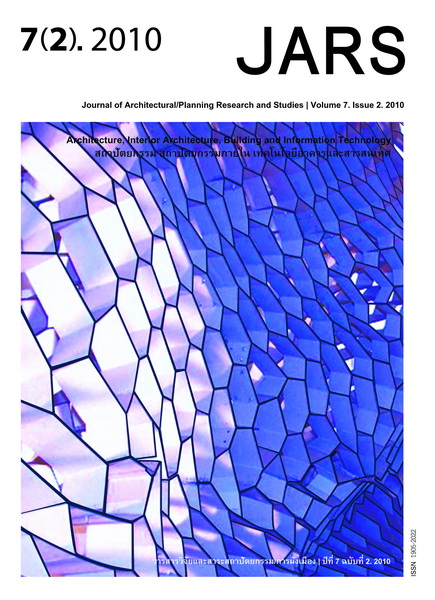Structures of the Eastern Constructional Beliefs
Main Article Content
Abstract
“Feng Shui” and “Vaastu” are the constructional beliefs which came from ancient China and India. At
present, they become the influential topics that determine the building configuration in many countries. But
sometimes, their contents conflict with the current scientific design principles. This study will expose their
influential factors which generate their contents and structures. The essences of this analysis can help us to
apply them in the proper way. By using scientific methods, the result of this study shows the Influential factors
of these beliefs such as; 1) Heaven factors are; climate, (air temperature, relative humidity, air pressure and
wind) time, (daytime-nighttime, seasons). 2) Earth factors are; topographical condition, water resources, landform,
land slope, geographical condition, altitude height, and natural resources. and 3) Human factors are;
administration of the city, social value, human comfort conditions, and human culture.
These constructional beliefs have been applied by superstitious way or deductive reasoning. Moreover,
the scopes of these beliefs are limited on their origin area in the period of time that the influential factors are
still not changed.
Downloads
Article Details

This work is licensed under a Creative Commons Attribution-NonCommercial-NoDerivatives 4.0 International License.
All material is licensed under the terms of the Creative Commons Attribution 4.0 International (CC-BY-NC-ND 4.0) License, unless otherwise stated. As such, authors are free to share, copy, and redistribute the material in any medium or format. The authors must give appropriate credit, provide a link to the license, and indicate if changes were made. The authors may do so in any reasonable manner, but not in any way that suggests the licensor endorses you or your use. The authors may not use the material for commercial purposes. If the authors remix, transform, or build upon the material, they may not distribute the modified material, unless permission is obtained from JARS. Final, accepted versions of the paper may be posted on third party repositories, provided appropriate acknowledgement to the original source is clearly noted.
References
Agarwal, R. (2005). Vaastu for trouble free success and prosperity in business and industry. Vasstu: The Ancient House Building Science of India, 5(1), 16-24.
Das, G. (2006). Benefit from force of nature: The vaastu way. The Chartered Accountant, 3(2), 976-978.
Dhechakasem, P. (2004). บ้านเฮง คนเฮง [ Auspicious house, human luck]. Bangkok: Quality Voice.
Feuchtwang, S. D. R. (1974). The anthropological analysis of chinese geomancy. Loas: Vithagna.
Knapp, R. G. (2005). Chinese house: The architectural heritage of a nation. Singapore: Tuttle Publishing.
Mak, M. Y., & Thomas, S. N. (2005). The art and science of Feng Shui–A Study on architect’s Perception. Building and Environment, 40(1), 427-434.
Montenegro, M. (2003). Feng Shui: The new dimensions in design. Christian Research Journal, 1(1), 1-7.
Schmieke, M. (2002). Vaastu, The origin of Feng Shui. India: Brijbasi Art Press.
Thongkamsamut, C., & Buranakarn, V. (2007). Form follows Feng Shui. Nakhara, 2(2), 37-53.
Wong, E. (1996). Feng Shui: The ancient wisdom of harmonious living for modern times. Boston: Shambala Publications.
Wong, E. (2001). A master course in Feng Shui. Boston: Shambhala Publications.
Yiamwattana, S. (2005). ฮวงจุ้ย วิถีแห่งธรรมชาติ [Feng Shui: The way to live in harmony with nature]. Bangkok, Thailand: Se-ed Eucation.
Yuan, D. (2005). Kan Yu (Feng Shui): The forgotten perspective in the understanding of intangible setting in China’s heritage sites. Science and Technology, 2(2), 230-250.


